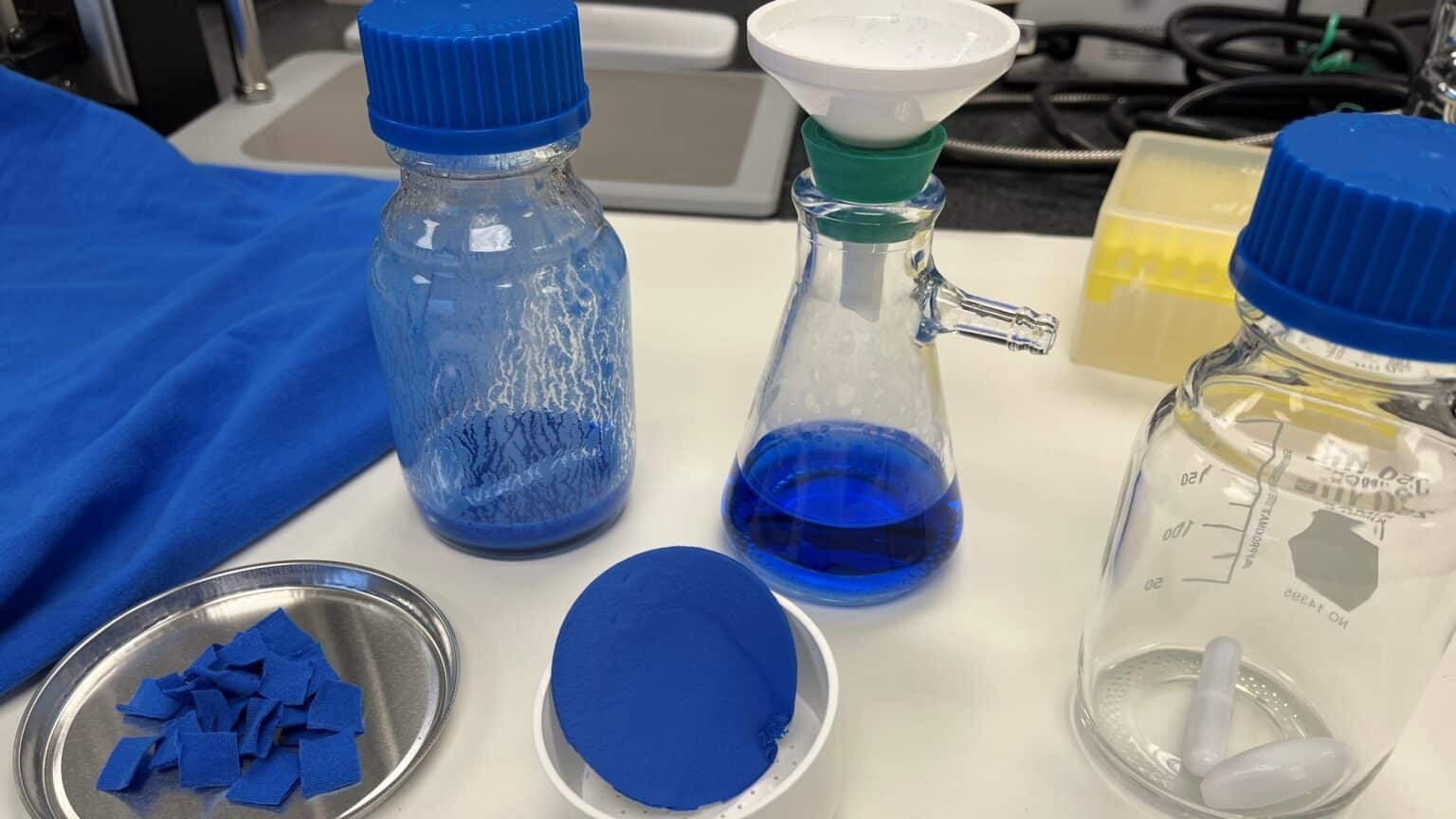North Carolina State University scientists discovered a way to separate blended cotton and polyester fabric using enzymes, which are nature’s tools for speeding up chemical reactions. They hope their outcomes will result in a more efficient method of recycling the fabric’s component materials, reducing textile waste.
 A cotton knit fabric dyed blue and washed ten times to simulate worn garments is enzymatically degraded to a slurry of fine fibers and “blue glucose” syrup separated by filtration. Both of these separated fractions have potential recycle value. Image Credit: Sonja Salmon.
A cotton knit fabric dyed blue and washed ten times to simulate worn garments is enzymatically degraded to a slurry of fine fibers and “blue glucose” syrup separated by filtration. Both of these separated fractions have potential recycle value. Image Credit: Sonja Salmon.
However, they discovered that if the blended fabric was dyed or treated with chemicals that significantly increased wrinkle resistance, the process required more steps.
We can separate all of the cotton out of a cotton-polyester blend, meaning now we have clean polyester that can be recycled. In a landfill, the polyester is not going to degrade, and the cotton might take several months or more to break down. Using our method, we can separate the cotton from polyester in less than 48 hours.
Sonja Salmon, Study Corresponding Author and Associate Professor, Textile Engineering, Chemistry and Science, North Carolina State University
According to the Environmental Protection Agency, consumers in the United States throw approximately 11 million tons of textile waste into landfills each year. The investigators wanted to find a way to separate the cotton from the polyester so that each component material could be recycled.
Scientists used a “cocktail” of enzymes in a slightly acidic solution to chop up cellulose in cotton. Cellulose is the material that provides structure to the cell walls of plants. The aim is to chop up the cellulose so that it “falls out” of the blended woven structure, releasing tiny cotton fiber fragments and glucose behind.
Glucose is a biodegradable by-product of cellulose degradation. The glucose is washed away, and the cotton fiber fragments are filtered, leaving clean polyester.
This is a mild process—the treatment is slightly acidic, like using vinegar. We also ran it at 50 ºC, which is like the temperature of a hot washing machine. It’s quite promising that we can separate the polyester to a clean level. We still have some more work to do to characterize the polyester’s properties, but we think they will be very good because the conditions are so mild. We’re just adding enzymes that ignore the polyester.
Sonja Salmon, Study Corresponding Author and Associate Professor, Textile Engineering, Chemistry and Science, North Carolina State University
They likened the degradation of 100% cotton fabric to that of cotton and polyester blends and fabric dyed with reactive red and blue dyes and treated with durable press chemicals. The scientists had to increase the time and enzymes to break down the dyed materials. They had to use a chemical pre-treatment before adding the enzymes to fabrics treated with durable press chemicals.
The dye that you choose has a big impact on the potential degradation of the fabric. Also, we found the biggest obstacle so far is the wrinkle-resistant finish. The chemistry behind that creates a significant block for the enzyme to access the cellulose. Without pre-treating it, we achieved less than 10% degradation, but after, with two enzyme doses, we were able to fully degrade it, which was a really exciting result.
Jeannie Egan, Study Lead Author and Graduate Student, North Carolina State University
The polyester can be recycled, while the slurry of cotton fragments might be useful as an additive for paper or a helpful addition to composite materials, according to the researchers. They are also looking into whether glucose can be used to create biofuels.
Salmon notes, “The slurry is made of residual cotton fragments that resist a very powerful enzymatic degradation. It has potential value as a strengthening agent. For the glucose syrup, we’re collaborating on a project to see if we can feed it into an anaerobic digester to make biofuel. We’d be taking waste and turning it into bioenergy, which would be much better than throwing it into a landfill.”
Journal Reference
Egan, J., et al. (2023). Enzymatic textile fiber separation for sustainable waste processing. Resources, Environment and Sustainability. doi.org/10.1016/j.resenv.2023.100118.
Source: https://www.ncsu.edu/